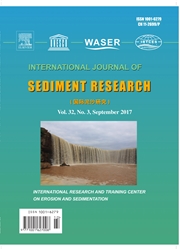

 中文摘要:
中文摘要:
步水池系统和卵石簇是由大石头组成的结构,山 streambeds 上的卵石由洪水流动重排到达高抵抗和高床稳定性。床结构和床负担运动能保护河床免受切口的伤害。在每个步水池,流动精力被转变成骚乱,并且最后进热。床负担运动也消费流动精力并且起一个作用保护床免受侵蚀的伤害。有床的床负担粒子的碰撞导致力量,作为散力量知道,它平衡电梯力量并且控制床的侵蚀沉积。域调查和域实验在中国的云南贵州高原上在 Xiaojiang 河盆被进行,在与床负担运动或与步水池系统有切入的流和稳定的流的地方。这研究表明为给定的溪流力量,强壮的床结构与被联系低或零床负担交通;并且弱或没有床结构与集中的床被联系负担运动。如果有床负担运动或有床结构,实验证明为切入的溪流,最后的床侧面是一样。当钥匙投掷完成了床结构那时,例如在步的大大石头,被移开,流动立即搜索了沉积床。严厉地到 100 次和床负担的中部的直径增加的床负担交通到 2-20 时间增加了。床结构和床负担运动为他们流动精力消费和 streambed 切口控制上的效果是互相可替代的。这是床负担运动和床结构的相等的原则。在一个很强壮的步水池系统发展了的地方,,尽管是由于原则在 Yalutsangpo 宏大峡谷没有床负担运动床坡度并且砍流动的应力极其高。为三个峡水坝的下游的活动范围的切口控制的这个原则的一个可能的应用程序也在这份报纸被讨论。
 英文摘要:
英文摘要:
Step-pool systems and cobble clusters are structures composed of boulders and cobbles on mountain streambeds rearranged by flood flow to reach high resistance and high bed stability. Both bed structures and bed load motion can protect the riverbed from incision. At each step-pool, the flow energy is transformed into turbulence, and finally into heat. Bed load motion also consumes flow energy and plays a role to protect the bed from erosion. The collision of bed load particles with the bed results in a force, known as dispersive force, which balances the lift force and controls the erosion of bed sediment. Field investigations and field experiments were conducted in the Xiaojiang River basin on the Yunnan-Guizhou plateau of China, where there were incised streams and stable streams with bed load motion or with step-pool systems. This study reveals that for a given stream power, strong bed structures are associated with low or zero bed load transportation; and weak or no bed structures are associated with intensive bed load motion. Experiments showed that for incised streams, the final bed profiles were the same if there was bed load motion or there were bed structures. When key stones that made up the bed structures, for instance the large boulders in steps, were removed, the flow immediately scoured the sediment bed. The bed load transportation sharply increased by 100 times and the median diameter of bed load increased by 2-20 times. Bed structures and bed load motion are mutually replaceable for their effects on flow energy consumption and streambed incision control. This is the principle of equivalency of bed load motion and bed structures. It is due to the principle that there was no bed load motion in the Yalutsangpo Grand Canyon, where a very strong step-pool system had developed, although the bed gradient and shear stress of flow were extremely high. A possible application of this principle for incision control of the downstream reaches of the Three Gorges Dam is also discussed in this paper.
 同期刊论文项目
同期刊论文项目
 同项目期刊论文
同项目期刊论文
 期刊信息
期刊信息
